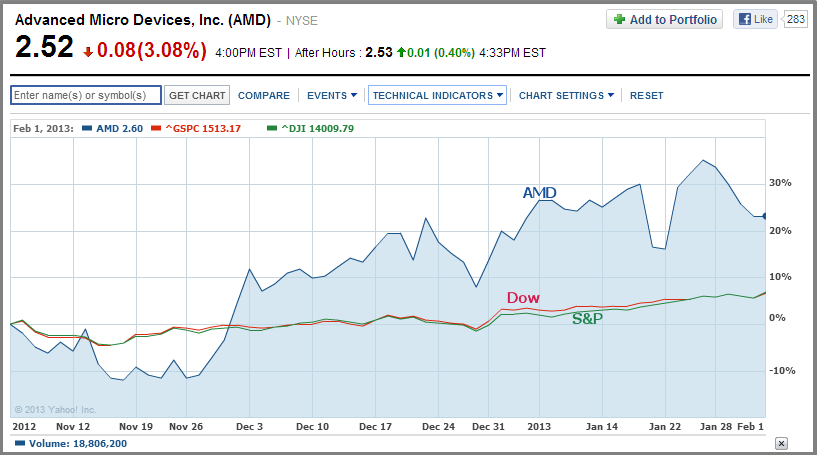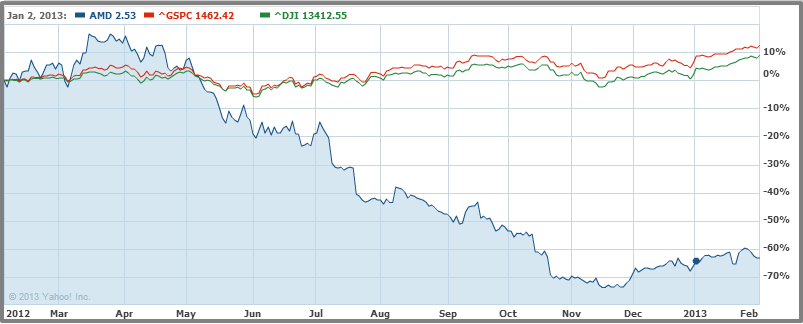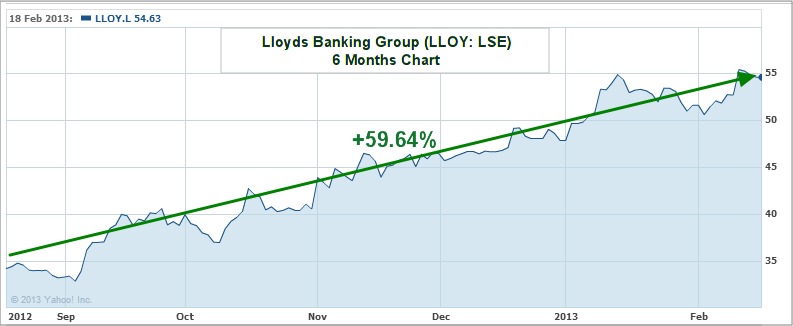Advanced Micro Devices Stock Rises
Since November of 2012, the stock of Advanced Micro Devices (AMD) has risen over 23% – beating the S&P 500 and the Dow by over 20% during this period.
Click here to Review the Latest Article on AMD Stock (Buy or Sell: 2013 – 2014)
The rise in the stock price over this three month period has been due to encouraging holiday sales, AMD's selling of its Austin, Texas campus to increase cash reserves ($150-$200 million) and news from the firm's CEO, Rory Read that the PC market will improve during the 2nd half of 2013. “I do believe the PC segment in general will have some refresh over the second half of 2013 so I think that will have demand generation,” stated Read during a recent Credit Suisse technology conference.
23.22% Rise in AMD Stock Price

However, stock analysts and investors do not believe in AMD’s comeback story. Looking back longer than 3 months, the stock has fallen over 60% since February of 2012. Three days ago (2/1/13), analysts at Ford Equity Research released a report reiterating AMD stock as a strong sell. They noted AMD's decreasing EPS (from $0.52 to – $0.43) and negative Operating Earnings Yield of -16.5%
AMD – 1 Yr (2/2012 – 2/2013) Stock Decline (63% Plunge)

Advanced Micro Devices (AMD) Analysis Breakdown – Is the Stock a Buy, Sell or Hold?
- Fundamental Analysis
- Valuation Overview
- Technical Perspective
- Favorable Catalysts
- Bottom Line Conclusion
- Fundamental Analysis
Founded in 1969, AMD manufactures and markets the technology (microprocessors) that enhances the applications that power millions of PCs, servers, and notebooks. In 2012, the firm earned $5.4 billion in revenue. After paying $6.5 billion in operating expenses (COGS, Selling/General/Admin expenses, Depreciation and other expenses), the company had an operating loss of -$1.05 billion.The decline in PC sales caused by an increase in consumer demand for tablets and other mobile devices has aggravated the deterioration in AMD’s financial and operating prospects. AMD’s 2013 Q1 guidance is for a 6%-12% decline in Q1 earnings as it continues to face pressures from weak PC demand and tough competition from Intel and NVidia.
- Valuation Overview
AMD has a debt of $2.04 billion and is not earning enough from day-to-day operations to service its debt. Its operating cash flow is -$338 million and quarterly revenue growth is declining at a year over year rate of -31.7%. They have a Return on Equity of -111.18% and a trailing twelve months (ttm) profit margin of -21.82%. EPS Growth (MRQ) is -167.92% (versus -46.63% industry average) and their revenue growth is -37% compared to the industry average of 11%.
- Technical Perspective
Advanced Micro Devices’ Moving Average Convergence Divergence (MACD) – technical analysis indicator used to identify changes in a stock's strength, direction and duration – is showing a bearish sentiment with a -26.52% change. The firm’s 130-day Raw Stochastics is also in Bearish territory.
- Favorable Catalysts
Key factors that can help support AMD’s stock in 2013 include an improvement in the global economy, success in the company’s restructuring efforts and effective diversification. In a recently published S&P stock report on AMD, Standard & Poor’s analysts rated AMD stock a HOLD. As stated on their report: “We believe AMD has made progress in its development efforts, yet this does not appear to be translating into significant market share gains and growth. The company is in the process of launching into new markets such as micro servers and ARM core chip technology in low-power servers”.
- Bottom Line Conclusion
Taking the various fundamental, valuation, technical and other analyses into consideration, we do not believe AMD stock is a prospective long term opportunity. Investors can gain better stock returns elsewhere.
See Updated Article on AMD Stock: Buy or Sell AMD in 2013 – 2014? AMD Stock Valuation







